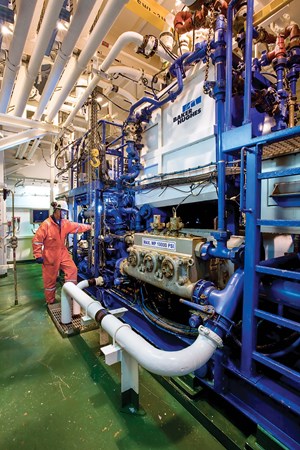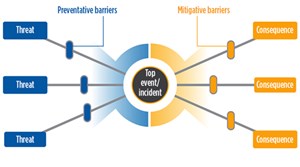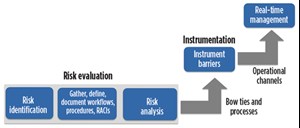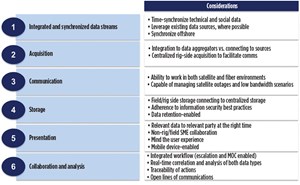Real-time operations improve process, safety and quality assurance in offshore cementing
Among the challenges to safe, effective execution of today’s highly demanding offshore development programs, few if any are more critical than well control and isolation. With regard to cementing and real-time communications, the future clearly is being shaped by the need to minimize health, safety and environmental (HSE) risk exposure, and to optimize operational efficiencies.
Ensuring safety at the wellsite, and performing the job effectively, on-time and on-budget, are crucial to the success of well cementing efforts. As offshore operations become more remote and seasoned experts depart the industry, a step change in the way that cementing operations are carried out is necessary to drive process safety and quality assurance. Leveraging the latest developments in situational awareness and real-time technologies can drive this change. The ability for real-time technologies to drive remote operations and shore-based monitoring, management and—eventually—control, will help the industry unlock and support the potential in these unchartered waters.
CURRENT SITUATION
Rig site activities, and their impact on personnel and process safety, have been the subject of industry reports and discussions for many years. Industry statistics suggest that many operational incidents, and most well control mishaps, occur as a result of human factors, such as misinterpretation of data, delayed response to abnormal well conditions and drilling crews’ physical fatigue. There is consensus among stakeholders—from the industry as a whole to governmental agencies—about the need for key initiatives. To reduce HSE risk exposure, both to avoid potential incidents and to reliably contain the impact of incidents that may occur, these initiatives would include reducing the number of personnel at wellsites, introducing regulatory-driven requirements, and a stronger focus on process assurance.
Next to ensuring safety at a wellsite, the ability to perform a job, on-time and on-budget, is the most critical factor to the success of well cementing efforts. The cementing job plan and corresponding procedures must be conducted as designed, and the cementing unit and supporting equipment must be available and reliable during the job. Cementing operational efficiency is driven primarily by equipment reliability, crew experience, and geographical and logistical challenges. Unplanned equipment downtime directly impacts the ability of the crew to deliver the cement at the time designated by the cementing plan. The trickle-down effect can lead to significant non-productive time (NPT).
The challenges to wellsite safety and operational efficiency of offshore cementing operations are exacerbated by the fact that the industry is faced with 44% of offshore personnel having fewer than three years of experience. This percentage is only going to increase, as we go deeper into a workforce transition phenomenon. The days when cementing engineers can rely on 10 to 20 years or more of experience to handle the complexities of their jobs are disappearing. The experienced crews are in high demand across the enterprise, usually providing support on critical jobs.
THE OPPORTUNITY
Innovative technologies and approaches present us with opportunities that, if we leverage them as an industry, can maintain and even enhance both safety and operational efficiency of offshore cementing operations. These opportunities include developing and enforcing standard procedures/workflows across all relevant members of the cementing team, bridging communication across all involved, enhancing traceability of actions, and ensuring a greater level of transparency around key actions taken by team members.
Taking lessons learned from other industries with similar risk profiles, we can achieve safety, process and quality assurance by providing the following:
- A “second set of eyes” to drive the necessary process and quality assurance;
- Access to a trusted advisor to back up remote resources during the critical junctures of the job.
One approach that the industry as a whole, and the cementing function specifically, have taken, to understand risk exposure, is the “bow tie” framework, developed by the HSE profession to analyze what contributes to incidents, what barriers could be put in place to prevent them, and how to contain them if they occur, Fig. 1.
The diagram in Fig. 1 is an abstraction of the bow tie model. The left side of the diagram (incident prevention) makes explicit the various threats that we face during an operation, the precursors that signal the presence of a threat, and the preventive barriers—people, processes and technologies—that we should activate to avoid the threat becoming a “top event,” or incident (the center of the bow tie). The right side of the diagram (incident response) makes explicit the response workflows that may follow an incident, the mitigation barriers that we should activate to contain the incident’s impact, and the consequences we will face, if the barriers fail.
The bow tie framework is a very useful tool for rigorous analysis, information-sharing and documentation. However, it doesn’t allow an organization to impact human factor risks in real time. Specifically, this refers to the ability to detect threats, to validate and verify that barriers are operational and in use, and to be proactive about risk management.
THE REAL-TIME ENVIRONMENT
Real-time technologies can play a key role in helping the industry realize the full potential of the bow tie framework by moving beyond the static realm of documentation into the “live” world of day-to-day operations. A real-time environment can minimize the threat of HSE risk, as well as downtime, and can allow operations to continue safely and efficiently.
To be effective, the real-time environment must offer cementing teams the ability to achieve four goals.
- Ownership: the ability to view, manage and impact jobs in real time.
- Coordination: the ability to coordinate responsible parties, and ensure that jobs and workflows are executed properly.
- Collaboration: the ability to ensure that all responsible parties are engaged and contributing.
- Analysis: the ability to record job execution, to drive continuous improvement and ensure traceability.
These goals can be facilitated with instant access to expert knowledge. Present-day cementing involves highly trained engineers, field supervisors and coordinators, who manage the cementing job and the corresponding equipment. The present operating environment must evolve the leveraging of key remote cementing experts, driven by real-time job response, to improve job execution and process management.
The latest technologies allow for more innovative approaches to knowledge-sharing by centralizing long-term experts, and allowing them to share their experience across multiple job sites, not just critical wells. Such an arrangement can provide crews with a trusted virtual advisor, who is available, as needed, to guide them through key parts of the cement job plan. This arrangement provides remote cementing personnel the capability to observe operations, as well as choreograph event responses in real time, Fig. 2.
THE REAL-TIME TECHNOLOGY TOOLKIT
To deliver on the promise of improving process, safety and quality assurance, technologies must enable cementing engineers to continually watch, respond and review in real time. The enabling technologies help the remote cementing engineer to understand what is happening, where it is happening, and how to respond. Watching in real time enables the engineer to “own” and create a “common view” of operations. It requires acquisition, display and transmission of technical data (from rig sensors, both surface and downhole), and social data (video, audio, GPS/GIS, screen capture), in an integrated manner.
Responding in real time allows the engineer to coordinate and collaborate, and technically integrate, the standard process with the common view. It depends on a multimedia workflow management system that triggers and manages an appropriate response, and verifies that it has been taken. Reviewing in real time answers the analysis requirement for the real-time environment and can be a driving force for continuous improvement in safety, process and quality. It involves the synchronized multimedia recording, replay and analysis capability of everything performed or accomplished in “watch” and “respond” phases of the operation.
APPLYING REAL-TIME TECHNOLOGIES
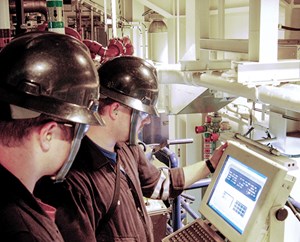
Effective implementation of the watch-respond-review real-time toolkit requires that it be configured appropriately for both the shore-based subject matter expert (SME) and the offshore environment. This, in turn, requires a series of prerequisite steps prior to implementation that includes extensive understanding of the particular cementing plan or process, sufficient training to ensure that both offshore and shore-based personnel are ready to support the process, and the use of instrumentation to translate the cementing process or job plan into the technical toolkit requirements described above, Fig. 3.
Cementing process analysis and understanding. Effective, real-time cementing operations require understanding, and configuring the intended steps and desired results of the operation prior to conducting it. This requires knowing the parties involved in each step; what are their roles and responsibilities; where the process is being performed and the location(s) of equipment, data and visuals related to each step; and the timing and order of the steps—including whether they are parallel or serial—as well as incident mitigation protocols. Answering these questions for each part of the process provides the information needed to watch the relevant data, and the right time and response in real time.
This same information ensures that the workflow steps are configured properly to ensure effective, safe coordination and collaboration among the personnel executing the process or service. The information also creates a baseline of expected activities, to ensure that the review phase of the operation is productive. Any deviations from this path, whether appropriate or not, can be identified instantly and analyzed, and corrected if necessary, providing an opportunity for improving safety and efficiency.
Change management approach. A change-management approach must be at the forefront of any digital technology adoption. Real-time cementing operations are no exception. Most rig site cementing supervisors or coordinators have little-to-no opportunity to interact with a shore-based expert in real-time-appropriate RACI (responsible, accountable, consulted, informed) training, so role-playing simulations must be conducted prior to implementation. It is imperative that in any RACI protocol that is developed, the rig site cementing supervisor/coordinator is the responsible(R) and accountable (A) party for all rig site activities.
The shore-based expert, in his role as a trusted advisor, takes on the consulted (C) and informed (I) roles in the script. Once the RACI is finalized and understood by all relevant parties, the rig site supervisor/coordinator and shore-based expert need to be trained on the revised cementing process through a series of simulations and role-playing scenarios. The rig site cement supervisor/coordinator will only leverage the shore-based expert to the extent that there is mutual trust and familiarity. Simulations and role-playing will build comfort and trust between the two parties.
Instrumentation involves the hardware and software needed to accomplish an end and the act of providing or using those instruments, with a focus on the rig site cementing unit and the SME shore-based workstation. In technical applications, instrumentation includes dashboard gauges used to monitor functionality and performance, based on data acquired by sensors and transmitted to the requisite instruments. Instrumentation in cementing operations includes identifying data acquisition points, sensors and transmission channels, and data distribution and access tools that correspond to the cement job activities.
IT CONSIDERATIONS
Alignment of real-time technologies with the cementing company’s information technology (IT) organization is critical to successful operational outcomes. The implementation of the digital platform can take many forms, but it is based on the information and telecommunications infrastructure available to an organization. Figure 4 presents relevant IT functions and considerations for each.
DEPLOYMENT EXAMPLE
The application of the real-time technologies and approach described above to offshore cementing was a finalist for the 2014 World Oil Award for visualization and collaboration. Baker Hughes has applied this approach in the Gulf of Mexico. The business process, RACI and instrumentation analysis yielded the following minimum component requirements for the real-time operation:
- Pan-tilt-zoom (PTZ) cameras positioned over strategic points along the cementing unit
- Portable rig-certified camera available to the cementing personnel
- Two-way audio access between the rig site cementing personnel and the shore-based SME
- Real-time access to cementing job data
- Shore-based SME laptop, enabled with the appropriate watch, respond-and-review visualization tools to allow the SME to conduct activities from any locale
- Real-time video and audio surveillance, and collaboration with remote experts.
After the technology was put in place, the proposed cementing job procedures were configured and synchronized to the relevant video feeds, to enable remote expert response and process validation, as required. The cementing job process action, and the relevant data, were fed to the remote SME workstation, and the SME then validated, verified and advised during the execution. All relevant data and process actions were recorded and reported against. The traceable record created during the operation can be used to drive continuous improvement in, and knowledge of, offshore cementing operations.
BENEFITS
The transformation of offshore cementing into a living, real-time risk and process assurance service provides value at two levels. During real-time operations, it enables proactive risk management and active risk mitigation; managed barrier activation, coordination and incident mitigation across responsible parties and locations; visibility of a common picture of the operation to all entitled parties for more efficient and effective decision support; compliance with standard operating procedures and best practices; and traceability of incident detection and management, boosting the power of after-action reviews and improvement programs.
At another level, recording and analyzing integrated technical and operations data creates unprecedented opportunities for continuous improvement and compliance programs, covering technical activities, people, practices and behaviors. Organizations can feed the cycle of improvement through observation and analysis of operational records. In the course of normal operations, the records can be used to improve performance and lower risk. When critical steps of the cementing job are executed, the response is guided by the organization’s standard procedures and best practices. By analyzing the performance of these responses and the adherence to standards, additional adjustments and improvements can be made to create a positive, compound effect on operational performance and safety.
By leveraging the latest in situational awareness and real-time technologies, offshore cementing will usher in a new age, where the supervisors/coordinators can access the knowledge and live assistance of experts across the world. The potential is tremendous, not only for cementing, but also for other critical services. ![]()
ACKNOWLEDGMENT
Much of the information in this article is adapted from SPE paper 173454-MS, “Real-time process assurance of offshore cementing operations,” presented at the SPE Digital Energy Conference and Exhibition, held in The Woodlands, Texas, March 3-5, 2015.
- Coiled tubing drilling’s role in the energy transition (March 2024)
- Advancing offshore decarbonization through electrification of FPSOs (March 2024)
- Subsea technology- Corrosion monitoring: From failure to success (February 2024)
- Using data to create new completion efficiencies (February 2024)
- Digital tool kit enhances real-time decision-making to improve drilling efficiency and performance (February 2024)
- E&P outside the U.S. maintains a disciplined pace (February 2024)
- Applying ultra-deep LWD resistivity technology successfully in a SAGD operation (May 2019)
- Adoption of wireless intelligent completions advances (May 2019)
- Majors double down as takeaway crunch eases (April 2019)
- What’s new in well logging and formation evaluation (April 2019)
- Qualification of a 20,000-psi subsea BOP: A collaborative approach (February 2019)
- ConocoPhillips’ Greg Leveille sees rapid trajectory of technical advancement continuing (February 2019)

